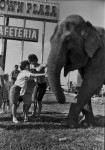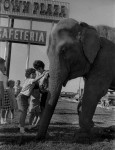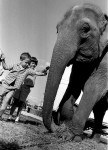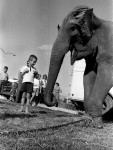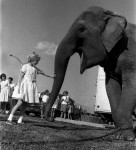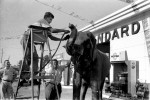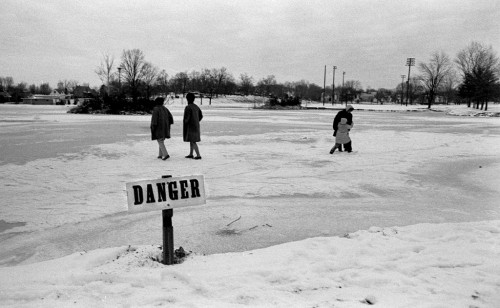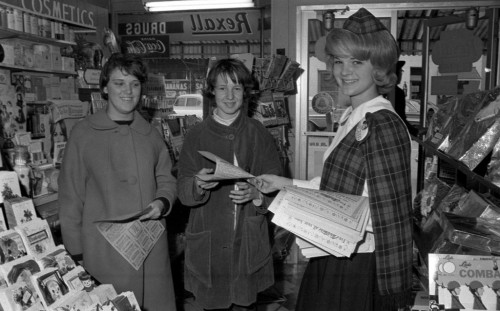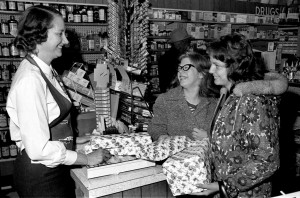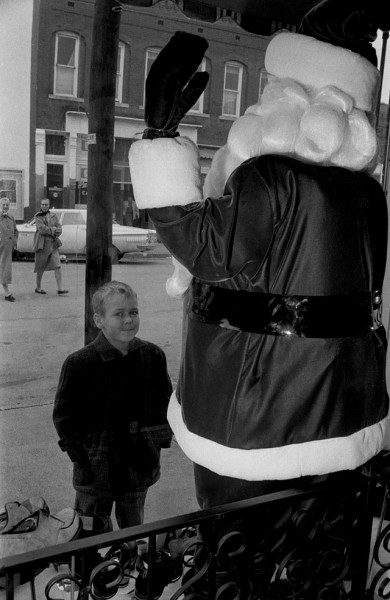 Hillary wrote that it takes a village. She got that right. It took a village of CHS readers to find a town – Jackson.
Hillary wrote that it takes a village. She got that right. It took a village of CHS readers to find a town – Jackson.
To recap: I posted a gallery of Christmas shopping pictures on Wednesday and confessed that I didn’t know where they were taken. Since one of them showed the inside of a Rexall Drugs store, I jumped to the conclusion that it had to be Unnerstall’s on Good Hope and that Santa would be nearby.
Santa drew guesses
My brother, Mark, missed the target completely. He thought it was taken from Shivelbine’s on Broadway.
Missourian photographer Fred Lynch keyed in on the telephone pole in the picture and convinced himself (and me) that it was taken on Good Hope near my original guess.
He sent me pictures that seemed to confirm it and I posted an update here. He followed it up with some pictures later taken from almost the same angle as mine that sure made it look like we had found the correct spot.
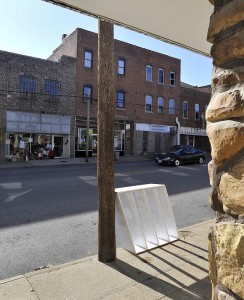 Bill Hopkins chimes in
Bill Hopkins chimes in
Emails with pictures attached start flowing in from Bill Hopkins, none of which are even close.
Blitstein sees problem
Chuck Blitstein posted a great description of Good Hope from the days when he worked at Cape Cut rate, but then he questioned our findings:
The location of your Santa photo presents a real conundrum, and the several ‘clues’ exacerbate the problem rather than lead to its resolve; e.g., the shoes in the window tend to make one think of a Men’s Clothing Store; in the 60s the shopping areas were Main Street, Broadway and Good Hope. Sides-Miller was in the 600 block of Broadway, Irvin’s and Ross Young were on Main but I do not remember a cafe/bar across from them. Al’s Mid-Town Lounge at 627 Good Hope might have had a Stag Beer sign, but the word Cafe doesn’t seem to fit and the location seems wrong for the picture. Hirsch’s might have sold shoes but again, the cafe/bar across the street? Then, there is the car, ’62 Dodge Dart? It looks like it is parked at an angle? I thought all on-street parking was parallel, but maybe not. Oh, well, a senior moment, I guess.
Hopkins questions Lynch
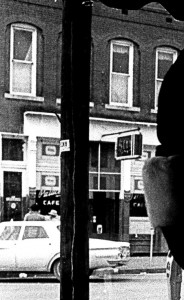 Bill Hopkins: Fred, take a look at the door in the Santa photo; it has a transom (is that the correct term?) above it and then a window offset slightly to the viewer’s right. In the photo of the building you propose as the correct one, that door (if it’s the same door) does not have such a window above it. In fact, the building you took a photo of shows those star thingies; they were connected to rods and helped support the building. My deceased pal Floyd Runnels (father of Jeanie Runnels Eddleman, the artist who draws historical buildings) was a bricklayer and explained that to me once. Of course I don’t remember what he said.
Bill Hopkins: Fred, take a look at the door in the Santa photo; it has a transom (is that the correct term?) above it and then a window offset slightly to the viewer’s right. In the photo of the building you propose as the correct one, that door (if it’s the same door) does not have such a window above it. In fact, the building you took a photo of shows those star thingies; they were connected to rods and helped support the building. My deceased pal Floyd Runnels (father of Jeanie Runnels Eddleman, the artist who draws historical buildings) was a bricklayer and explained that to me once. Of course I don’t remember what he said.
One more thing I noticed: the Santa building has drainage over the top windows; the suspect building does not.
Larry Saddler agrees with Blitstein
Larry Sadler: Chuck Blitstein points out that the car looks like it is angle parked. I agree with him. The sign on the window looks like it says Palace Cafe to me. I don’t remember the Palace Cafe in Cape Girardeau. Could this possibly be a picture taken in Jackson. I believe they used angle parking extensively in Jackson. The mystery continues.
So does Jesse James
Jesse James: Doesn’t look like the Santa picture is in Cape, notice the car is parked at an angle and not parallel. Don’t remember any places that was done in Cape, maybe Jackson?
Brenda Bone Lapp piles on
Brenda Bone Lapp: I agree with Jesse that the photo of the boy with the Santa in the storefront is taken in Jackson. I think it is somewhere in the area of the Square. It may be close to that store (I think it was a feed store) where they had the stuffed horse in the window. Remember that?
[Editor’s note: I sure do remember it. It was next door to The Jackson Pioneer, where I worked.]
Fred sends a flash bulletin
Fred Lynch: Flash! Santa mystery photo solved! Details to follow. (I have a day job.)
Clue: The utility pole is gone.
Fred discovers Santa in Jackson
[Here’s the complete account. Fred doesn’t normally talk about himself in the third person. He was trying to make it easy for me by making it look like I had actually written this, but I want to make sure he gets full credit for running around for two days and enlisting the help of a co-worker. I think we should make him an honorary member of Central High School 1960s’ Decade]
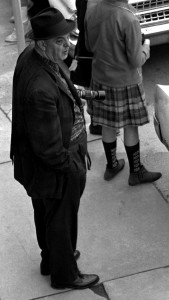 Fred Lynch: When photojournalist Fred Lynch is not taking pictures for The Southeast Missourian, a daily newspaper in Cape Girardeau, Mo., he can be found driving around looking at buildings to identify for Ken Steinhoff’s blog. Ken was Fred’s predecessor in the late 1960s at the Missourian.
Fred Lynch: When photojournalist Fred Lynch is not taking pictures for The Southeast Missourian, a daily newspaper in Cape Girardeau, Mo., he can be found driving around looking at buildings to identify for Ken Steinhoff’s blog. Ken was Fred’s predecessor in the late 1960s at the Missourian.
Fred is always up for a challenge, more so since starting his own blog, F/8 and Be There. Fred shares old photos of Cape Girardeau and their background with readers on the web site. Some of the pictures date back to the 1920s and earlier. Many have been taken by G.D. Fronabarger from the 30s to the 60s. Frony was Ken’s predecessor at the newspaper.
With an eye for detail, Fred checked a photo that Ken took of a child standing outside a store window that had a Santa Claus in it. Ken didn’t remember where it was taken, so he invited blog readers to help.
Looking for clues
Using two different frames of the photo that Ken provided, Fred found these clues:
- Utility pole
- Parking meter
- Two women walking across the street
- Automobile angle-parked
- Store across the street with Palace Cafe on the window
- The two-story building with distinctive second-floor windows, building trim
above the windows
- A glass case with a movie poster inside.
Fred first thought the scene was the 600 block of Good Hope. He even took pictures to support the theory. The pole was there and the windows were there, or so he thought. In the end, Fred could not fit the square peg into the round hole.
Wrong street. And wrong town.
The mystery Santa photo was not taken in Cape Girardeau. It was in Jackson.
 Fred began his quest with a call to Cathy Hancock at the Jackson office of The Southeast Missourian. She grew up in Jackson. Fred learned from Cathy that Rozier’s department store had a Santa in their window back in the 1960s
Fred began his quest with a call to Cathy Hancock at the Jackson office of The Southeast Missourian. She grew up in Jackson. Fred learned from Cathy that Rozier’s department store had a Santa in their window back in the 1960s
when Ken took the photo.
[Editor’s note: I was working for The Jackson Pioneer at the time, so it’s likely that I shot these pictures for it, and not The Missourian.]
Fred learned from Cathy that Jackson had a movie theater at the time, the Palace Theater. Cathy contacted a friend who confirmed there was a Palace Cafe next door to the theater.
Buildings change over decades. The utility poles on High Street are gone, as well as the parking meters. Rozier’s is now High Street Center, an office building. The theater is no more, but one can imagine it was there from the
front. Now it has a church and a beauty salon. The Palace Cafe is now Lloyd’s of Jackson, a bar. And so it goes with progress in Jackson..
[Thanks to Fred and Cathy at The Missourian and thanks to all of you who pulled out magnifying glasses to help solve this mystery.]


